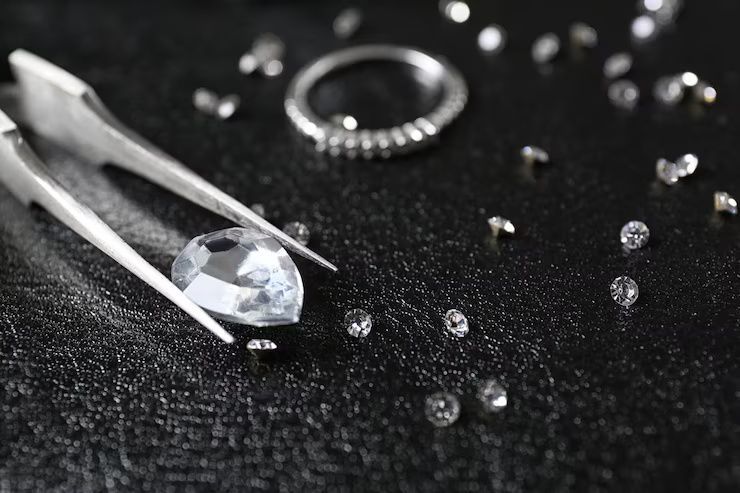Lab diamonds, also known as synthetic or man -made diamonds, are made in a laboratory instead of mining from the earth. These diamonds have physical, chemical and optical properties similar to natural diamonds. They are created using advanced technical processes, usually either high pressure high temperature (HPHT) or chemical steam deposit (CVD).
The concept behind the lab diamonds emerged to address the growing environment, moral and economic concerns associated with traditional diamond mining. The growing interest in stability and transparent purchases has promoted growth and demand for laboratory -developed alternatives.
Why Lab Diamonds Mean Something Today
Lab diamonds play an important role in many areas of modern society. Here's the reason they draw attention:
Environment and moral influence
-
No mining involves, lowering landfall and dissolution of the ecosystem.
-
Conflict or "blood" diamond problems are avoided.
-
Reduces water use and carbon emissions compared to traditional mining.
Financial access
-
Usually mining cheaper than diamonds.
-
At a low price, the same aesthetic price and quality, making diamonds available for wider target groups.
Extension of industry applications
In addition to jewelry, lab diamonds are used quickly:
-
Electronics and semiconductor
-
Medical equipment and optical equipment
-
Quantum calculation and laser with high damping
Lab Diamond Newer Trends and Development
Lab Diamond Industry has seen remarkable changes over the past year:
These updates suggest that the lab diamond is not only a trend, but an increasing part of both luxury and technology.
Legal Guidelines and Industry Regulations
Lab diamonds are subject to various policies based on land or region:
United States
-
The Federal Trade Commission (FTC) updated its jewelry guide in 2018, until it is obviously worthy (eg the lab layer, man-made) The term "diamond" was allowed for laboratory-developed variants.
-
In order to avoid misleading consumers, it must obviously be revealed.
EU
-
It is necessary for the International Organization for Standardization (ISO) and national jewelery bodies that Lab Diamonds is marked and revealed at the point of view.
-
France and Germany maintain strict compliance with original disclosure.
India
-
In 2023, the government of India announced a research scholarship to promote CVD technology.
-
India emerges as a global center for lab diamond production due to cost capacity.
Global standard
-
Many countries follow guidelines from the World Jewelry Confederation (Cibjo) that promote openness and moral practice.
-
Certification bodies such as IGI and GIA provide grading reports for laboratory -developed diamonds similar to natural diamonds.
The purpose of these rules is to protect consumers and maintain confidence in the diamond market.
Lab Diamond Buyers Accessories and Resources
There are many equipment and websites available to help consumers, researchers and professionals make informed decisions:
Professional resources
-
GIA (Gemological Institute of America) - Lab provides detailed explanation, research and grading of reports for diamonds.
Website: www.gia.edu -
IGI (International Gemological Institute) issues certification for Lab-Groe Diamonds and provides grading services.
Comparison tool
-
Rarely karat - compares the prices of laboratory and natural diamonds in many dealers.
Website: www.rarecarat.com -
Large Earth Lab Diamond Quiz - helps users choose between diamond types based on moral and pricing preferences.
Interactive calculator
-
Cost comparison is available on websites such as calculator - Diamond Pro, so users can compare karate -size prices and types.
Report and market insight
-
Mcinse & Company - Diamond Industry Report (2024)
-
Ban & Company - Global Diamond Report
These resources provide transparent data and educational assistance to those interested in buying or learning more about lab-developed diamonds.
Frequently Asked Questions (Common Questions)
Are lab diamonds real diamonds?
Yes. Lab-Gro diamonds are real diamonds, only one has physical and chemical properties such as diamonds. They are not fake, simulant or copying of cubic zirconia or moisnite.
How can I tell the difference between lab and natural diamonds?
The difference is not visible to the naked eyes. Advanced gemological tools are needed to identify lab-goose diamonds. The iconic suppliers reveal the origin and provide certification.
Are lab diamonds environmentally friendly?
They are usually more durable than mining diamonds and emit low land, water and low greenhouse gases. However, the use of energy in laboratories can vary from the production method.
Does the lab diamonds hold the price over time?
Like most consumables, laboratory diamonds are depreciated after the purchase. Natural diamonds may have a slightly more resale price, but there are neither strong investments than financial assets.
Can lab diamonds be used in engagement rings and jewelry?
Absolutely. Lab diamonds are widely used in all types of jewels, including engagement rings, earrings and bracelets. Many Jewers now offer collections with a hallmark of laboratories.
Conclusion
Lab diamonds change how we think of luxury, morality and stability in both fashion and technology. Understanding their origin, value and regulation, consumers can create informed alternatives that reflect their preferences and budget.
Whether you are considering a laboratory diamond for jewelry or searching for its scientific applications, this guide provides a basis for navigating this developed area.